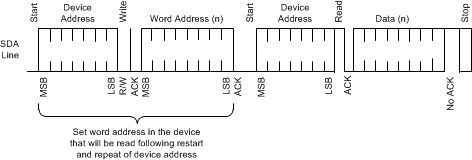SNLS568D March 2017 – May 2020 LMH1228
PRODUCTION DATA.
- 1 Features
- 2 Applications
- 3 Description
- 4 Revision History
- 5 Pin Configuration and Functions
- 6 Specifications
-
7 Detailed Description
- 7.1 Overview
- 7.2 Functional Block Diagram
- 7.3
Feature Description
- 7.3.1 4-Level Input Pins and Thresholds
- 7.3.2 OUT0_SEL and SDI_OUT2_SEL Control
- 7.3.3 Input Signal Detect
- 7.3.4 Continuous Time Linear Equalizer (CTLE)
- 7.3.5 Clock and Data (CDR) Recovery
- 7.3.6 Internal Eye Opening Monitor (EOM)
- 7.3.7 Output Function Control
- 7.3.8 Output Driver Control
- 7.3.9 Status Indicators and Interrupts
- 7.4 Device Functional Modes
- 7.5 Register Maps
- 8 Application and Implementation
- 9 Power Supply Recommendations
- 10Layout
- 11Device and Documentation Support
- 12Mechanical, Packaging, and Orderable Information
Package Options
Mechanical Data (Package|Pins)
- RTV|32
Thermal pad, mechanical data (Package|Pins)
- RTV|32
Orderable Information
7.4.1.1.2 SMBus Read Operation Format
SMBus read operation consists of four parts, as illustrated in Figure 15:
- The master begins with a start condition, followed by the slave device address with the R/W bit set to 0'b.
- After an ACK from the slave device, the 8-bit register word address is written.
- After an ACK from the slave device, the master initiates a restart condition, followed by the slave address with the R/W bit set to 1'b.
- After an ACK from the slave device, the 8-bit data is read-back. The last ACK is high if there are no more bytes to read, and the last read is followed by a stop condition.
 Figure 15. SMBus Read Operation
Figure 15. SMBus Read Operation